传递过程原理-附件-英文版
通信原理 英文

通信原理英文Communication PrinciplesCommunication principles refer to the fundamental concepts and theories that govern the process of transmitting information from one entity to another. These principles form the foundation of effective communication and play a crucial role in various communication systems, such as wireless communication, optical communication, and digital communication.One of the key communication principles is the concept of encoding and decoding. Encoding involves converting the information into a suitable form for transmission, while decoding involves the reverse process of converting the received signals back into meaningful information. This principle ensures that the information is accurately transmitted and understood by the receiving entity.Another important principle is the concept of modulation. Modulation is the process of modifying a carrier signal by varying its amplitude, frequency, or phase to carry the information. This principle is used in various communication systems to transmit information over long distances without significant loss or distortion.Furthermore, the principle of noise reduction is crucial in communication systems. Noise refers to any unwanted disturbance that affects the quality of the transmitted signal. To ensure reliable and clear communication, noise reduction techniques, such as filtering and error correction, are employed to minimize the impactof noise on the received signals.Additionally, the principle of multiplexing allows multiple signals to be transmitted over a single communication channel. This is achieved by dividing the channel bandwidth into smaller sub-channels, each carrying a different signal. Multiplexing enables efficient utilization of the available communication resources and allows for simultaneous transmission of multiple signals.Furthermore, the principle of synchronization is essential for successful communication. Synchronization ensures that the transmitting and receiving entities are operating in a coordinated manner, allowing for accurate transmission and reception of the information. Various techniques, such as clock synchronization and frame synchronization, are employed to achieve synchronization in communication systems.Lastly, the principle of error detection and correction is crucial for reliable communication. Error detection techniques, such as checksums and parity bits, are used to identify errors in the transmitted signals. Error correction techniques, such as forward error correction codes, are employed to correct the detected errors and ensure accurate transmission and reception of the information. In summary, communication principles are fundamental concepts and theories that govern the process of transmitting information. These principles, such as encoding and decoding, modulation, noise reduction, multiplexing, synchronization, and error detection and correction, ensure efficient and reliable communication in various communication systems.。
传递现象.ppt
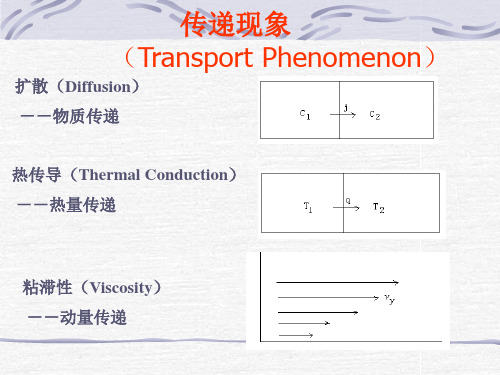
传递现象-非恒稳态传递过程
2. 在确定了微分方程后,对于每一特例,必须确定相应的初始 条件或边界条件才能得到正确的解。
本例中, 边界条件为:z=0,cB=c0; z=,cB=0
c 解此方程可得: B
c0 (1 erf )
z
4Dt
erf为误差函数 erf 2 e 2 d
0
传递现象-非恒稳态传递过程
传递现象-讨论
3. 牛顿冷却定律
q H T边界-T环境
物体冷却时放出的热通量q 与物体边界与环 境的温度差成正比
传递现象-非恒稳态传递过程
设有一半无限平板型膜,一面维持恒定的浓度c0,另一面延 伸至无穷,初始时刻,膜内各处浓度均为0,求不同时间膜内 浓度的分布。
建立微分方程如下:
1. 首先选取适当微体 积元进行分析,本例 中,选取距离为z,厚 度为dz的微体积元 Asdz进行物料衡算 该微元在dt时间内的流入、流出和积累分别为:
(1)
则上下两池的浓度随时间变化为:
dcB上 jB As ,
dt
V上
dcB下 jB As dt V下
d cB下 cB上
dt
jB As V上1 V下1
将(1)式代入
d cB下 cB上
dt
DBA
As l
V上1 V下1
(cB下 cB上 )
传递性质的实验测定
d cB下 cB上
热传导(Thermal Conduction) --热量传递
传递现象-粘滞性(Viscosity)
粘滞性(Viscosity) --动量传递
传递现象 (Transport Phenomenon)
总结:
1. 从微观成因看,物质传递、热量传递和动量 传递都是由于分子的无规则热运动引起的, 是大量分子热运动的统计平均行为。为与因 流体整体运动引起的传递相区分,我们称上 述三种传递现象为分子传递现象
传质过程 英语
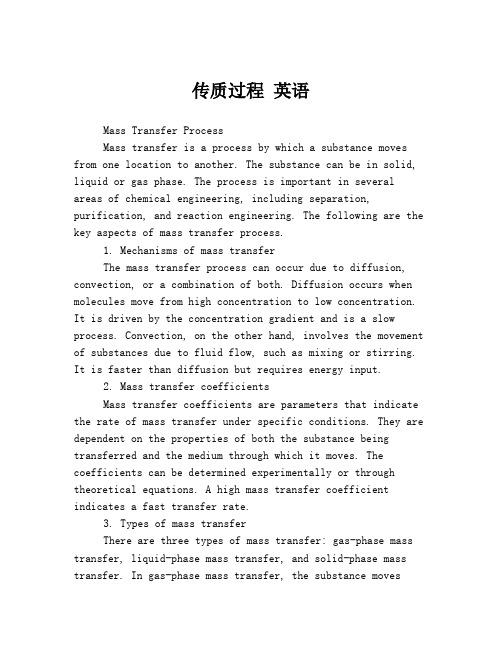
传质过程英语Mass Transfer ProcessMass transfer is a process by which a substance moves from one location to another. The substance can be in solid, liquid or gas phase. The process is important in several areas of chemical engineering, including separation, purification, and reaction engineering. The following are the key aspects of mass transfer process.1. Mechanisms of mass transferThe mass transfer process can occur due to diffusion, convection, or a combination of both. Diffusion occurs when molecules move from high concentration to low concentration. It is driven by the concentration gradient and is a slow process. Convection, on the other hand, involves the movement of substances due to fluid flow, such as mixing or stirring. It is faster than diffusion but requires energy input.2. Mass transfer coefficientsMass transfer coefficients are parameters that indicate the rate of mass transfer under specific conditions. They are dependent on the properties of both the substance being transferred and the medium through which it moves. The coefficients can be determined experimentally or through theoretical equations. A high mass transfer coefficient indicates a fast transfer rate.3. Types of mass transferThere are three types of mass transfer: gas-phase mass transfer, liquid-phase mass transfer, and solid-phase mass transfer. In gas-phase mass transfer, the substance movesbetween gas phases, such as from the air to water. In liquid-phase mass transfer, the substance moves between different liquid phases, such as from water to oil. In solid-phase mass transfer, the substance moves through a solid, such as a catalyst.4. Applications of mass transferMass transfer is used in several areas of chemical engineering, such as separation and purification processes. Distillation, extraction, and adsorption are some examples of separation processes that utilize mass transfer. In reaction engineering, mass transfer plays a critical role in controlling the rate of reactant delivery to the reaction site.In conclusion, mass transfer is an essential process in chemical engineering. Understanding its mechanisms, coefficients, and types is crucial for designing effective separation, purification, and reaction systems.。
传递过程原理03

第三章粘性流体运动的微分方程粘性流体连续性方程运动方程3.1粘性流体(Viscous Fluid )Newtonian fluid¾符合牛顿粘性定律的流体被称为牛顿流体,所有的气体和许多均相非聚合物液体Non-Newtonian fluid¾不符合牛顿粘性定律的流体被称为非牛顿流体,非牛顿流体在”流变学”(Rheology)中有专门的讨论;xyx du dyτη=-xdu dy η减少拟塑性随-之增加而增加胀塑性Apparent Viscosity非牛顿流体假塑性(Pseudoplastic)流体¾流体的表观粘度随剪切速率(速度梯度)的增大而减小。
¾聚合物溶液或熔融体、油脂、淀粉悬浮液、蛋黄浆和油漆等。
涨塑性(Dilatant)流体¾表观粘度随剪切速率的增大而增加。
¾玉米粉、糖溶液、湿沙和某些高浓度的粉末悬浮液等。
幂指流体¾m—稠度系数¾n—流动行为指数¾假塑性:n<1;涨塑性:n>1d m nx u dy τ⎛⎞=⎜⎟⎝⎠流变图粘塑性流体τ>临界值,流体运动,否则静止。
宾汉(Bingham)流体¾斜率固定,但不通过原点,该线的截距τ0称为屈服应力。
当剪应力超过屈服应力之后才开始流动,开始流动之后其性能像牛顿流体一样。
¾细颗粒悬浮液和糊状物质等。
凯森(Casson)流体¾曲线不通过原点,表观粘度与剪切速率呈非线性关系¾血液、酸奶、番茄酱、融化的巧克力0xyx yx xyx du dydu dyτμτττττ±>=<=-当当3.2 Equation of Continuity (Differential Mass Balance)dxdydz tρ∂∂ρρ∂−∂∂−∂()()y z u dxdydzy u dxdydzzρρρρ∂∂−+=−∂∂()()()x x x x u u u dydz u dx dydz dxdydzx x()()()x y z u u u t x y zρρρρ∂∂∂∂−=++∂∂∂∂()0u ρρ∂+∇=rElement of FluidsEquation of Continuity流体流动时的通用微分衡算方程,连续性方程推导过程中没有任何假设,适用于定常、非定常;理想流体、真实流体;可压缩、不可压缩流体;牛顿型流体、非牛顿型流体。
通信原理(英文版)课件
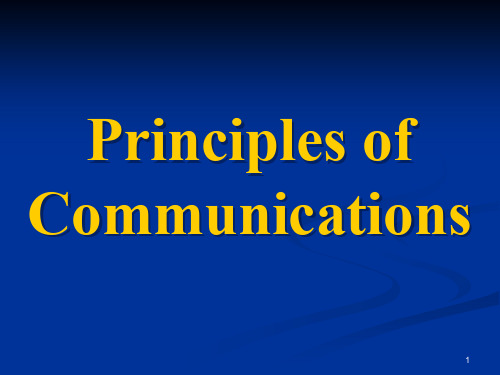
36
l 4-ary coding channel model
0
0
1
Transmitting end
2
1
Receiving end
2
3
3
Figure 1.4.12 4-ary coding channel model
37
1.4.4 Influence of channel characteristics on signal transmission
2
1.2 Message, information & signal
lMessage:speech, letters, figures, images…
lInformation:effective content of message. Different types of messages may contain the same information
# Information content I = I [ P(x) ],P(x) – Occurrence probability
# Definition:I = loga [1/P(x)] = -logaP(x) # Usually, set a = 2, the unit of the information content will be called a bit.
0
ω
0
Ideal characteristic
Ideal characteristic: phase --- () = k ;
group delay --- () = d()/d = k
Influence of distortion: waveform distortion, inter-symbol interference
传递过程原理 英文版教材
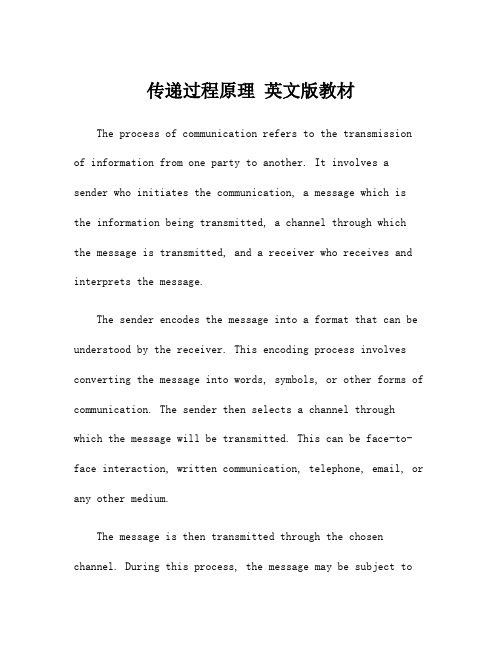
传递过程原理英文版教材The process of communication refers to the transmission of information from one party to another. It involves a sender who initiates the communication, a message which is the information being transmitted, a channel through which the message is transmitted, and a receiver who receives and interprets the message.The sender encodes the message into a format that can be understood by the receiver. This encoding process involves converting the message into words, symbols, or other forms of communication. The sender then selects a channel through which the message will be transmitted. This can be face-to-face interaction, written communication, telephone, email, or any other medium.The message is then transmitted through the chosen channel. During this process, the message may be subject tonoise or interference, which can affect its clarity and accuracy. The receiver, on the other end, decodes the message by interpreting the words, symbols, or other forms of communication used by the sender.Once the message is received, the receiver may provide feedback to the sender to indicate their understanding or ask for clarification. This feedback is an essential part of the communication process as it ensures that the message was successfully transmitted and understood.Overall, the communication process involves the transmission of a message from a sender to a receiver through a chosen channel. It requires effective encoding and decoding by both parties, as well as feedback to ensure successful communication.。
通信原理(英文版)3

Definition:
➢ Modulating signal m(t) -signal from the source
➢ Modulated signal s(t) - signal after being modulated
➢ Modulator - the device for modulation
Chapter 3 Analog modulation system
3.1 Introduction
Analog modulation: modulation of a carrier by a source
baseband analog signal
Carrier: a deterministic periodic waveform - cosinusoidal
ri
E
1 2
1
m'
(t
)2
A2
/ n2 (t)
∴Ratio of S/N before and after detection:
m(t)
1+m(t)
+1 = 1
0
1+m(t)
1
0
=
4
Frequency density
➢ Contain discrete carrier component ➢ When m(t) is cosinusoidal, and m=100%,
sum of the two side band power = half of carrier power
Basic principles
Let: m(t) = [1+m(t)], |m(t)| 1, m(t)|max = m -modulation index, then we have the AM signal
传递过程原理教材
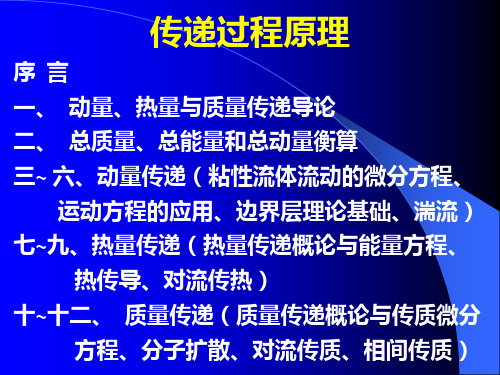
质量通量=
-(质量扩散系数)×(质量浓度梯度)
kg m2
s
[m 2
/
s]
kg / m3
m
jA
DAB
dA dy
(1 3)
通过分析可以得出以下几条结论: ① 动量、热量与质量传递的通量,都等 于该量的扩散系数与该量浓度梯度乘积的 负值,故三类分子传递过程可用一个普遍 化的表达式来表达即:
三传通量表达式一览表
动量 通量
只有分子运动 的传递
d (ux )
dy
涡流为主 的传递
r d (ux )
dy
两者兼有 的传递
t r
热量 通量
q d (c pt)
A
dy
( q )e A
H
d (cpt)
dy
q ( A)t
( q ) ( q )e AA
质量 通量JaFra bibliotekDAB
d A
dy
二、热量通量
傅立叶定律可写成:
q d(Cpt)
A
dy
(1 5)
k Cp
[m2 / s] 热扩散系数
该定律可理解为:导热通量=
-(热扩散系数)×(热量浓度梯度)
J m 2 s
[m 2
/ s]
J
/ m3 m
三、质量通量
对Fick定律中个动量物理意义和单位不需 要变形就可直接进行分析:
序言
三传的概念在1960年之前并未被人们普 遍接受,而在1960年前后才出现了“动 量、热量与质量传递”或“传递现象”这 一课程。
事实上,动量、热量与质量的传递是密不 可分的,
比如:如何有效移除反应堆中心部位 由裂变所产生的热量以防过热!!
通信原理(英文版)1
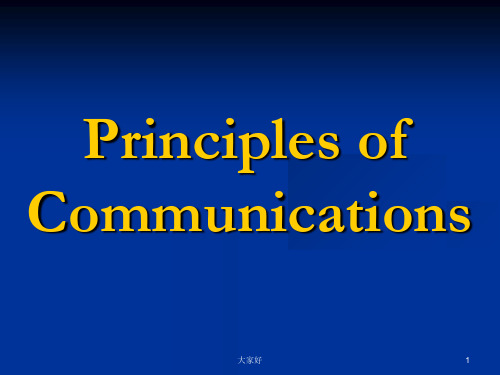
大家好
2
1.2 Message, information & signal
Message:speech, letters, figures, images…
Information:effective content of message. Different types of messages may contain the same information
Demodulation
Channel
Modulation
Informitter
1.3.4 Specifications of Digital
Communication Systems
Relationship between efficiency & reliability (rate ~ accuracy)
Two categories of signals
• Analog signal:Its voltage or current can be expressed by a continuous function of time. For example, speech signal.
• Digital signal: Its voltage or current can only take finite number of discrete values. For example, digital computer data signal.
(MF)
direction-finding, distress
calling, coast guard
大家好
17
Division of frequency band
Batch_reactor 传递理论与反应工程英文版课件

24
8. nth Order Reaction: nA Products
-rA = -dCA/dt = kCAn
1
C
n1 A
1 C n1
A0
(n 1)kt
C 1 n A
C1n A0
(n 1)kt
8
Advantages: • High conversions can be obtained • Versatile, used to make many products • Good for producing small amounts • Easy to Clean
Dis-advantages:
C2
CA0
A
0
1/CA – 1/CA0 = kt xA/(1-xA) = kCA0t
20
4. Second Order Reaction: A + B Products CA0 CB0
-rA = -dCA/dt = kCACB
ln
CBCA0 CB0CA
K(CB0-CA0)
t
ln
M xA 1 xA
BATCH REACTOR Interpretation of rate data
1
• Simplest reactor – open / closed vessel
• Reactants are placed inside the reactor and allowed to react over time
— Usually batch process, if the plants have production capacity less than 1x106 lb/yr (0.5x106 kg/hr).
通讯原理 英文
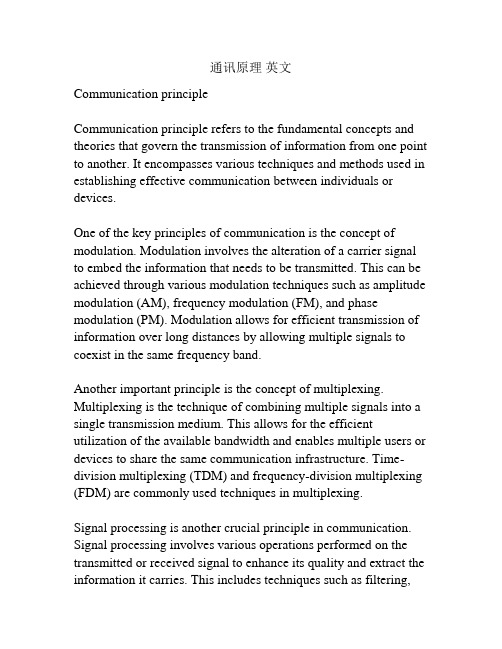
通讯原理英文Communication principleCommunication principle refers to the fundamental concepts and theories that govern the transmission of information from one point to another. It encompasses various techniques and methods used in establishing effective communication between individuals or devices.One of the key principles of communication is the concept of modulation. Modulation involves the alteration of a carrier signal to embed the information that needs to be transmitted. This can be achieved through various modulation techniques such as amplitude modulation (AM), frequency modulation (FM), and phase modulation (PM). Modulation allows for efficient transmission of information over long distances by allowing multiple signals to coexist in the same frequency band.Another important principle is the concept of multiplexing. Multiplexing is the technique of combining multiple signals into a single transmission medium. This allows for the efficient utilization of the available bandwidth and enables multiple users or devices to share the same communication infrastructure. Time-division multiplexing (TDM) and frequency-division multiplexing (FDM) are commonly used techniques in multiplexing.Signal processing is another crucial principle in communication. Signal processing involves various operations performed on the transmitted or received signal to enhance its quality and extract the information it carries. This includes techniques such as filtering,equalization, and error correction coding. Signal processing algorithms play a vital role in improving the reliability and accuracy of communication systems.Noise is an inherent part of any communication channel or medium. The principle of noise reduction is essential in ensuring clear and accurate communication. Various noise reduction techniques, such as filtering, error correction coding, and signal amplification, are employed to minimize the impact of noise on the transmitted signal.Encryption and decryption are principles used to secure communication. Encryption involves the process of converting the information into an encrypted form to protect it from unauthorized access. Decryption, on the other hand, is the process of converting the encrypted information back to its original form. Encryption techniques such as symmetric key encryption and public key encryption are widely used for secure communication.Overall, understanding the principles of communication is crucial for designing and implementing efficient and reliable communication systems. These principles form the foundation for various technologies and techniques used in modern communication systems, enabling seamless transmission of information across different platforms and devices.。
3GPP 5G基站(BS)R16版本一致性测试英文原版(3GPP TS 38.141-1)
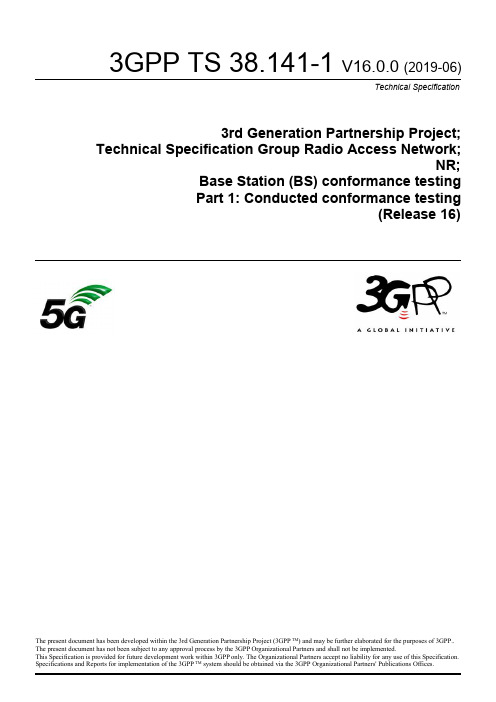
4.2.2
BS type 1-H.................................................................................................................................................. 26
4.3
Base station classes............................................................................................................................................27
1 Scope.......................................................................................................................................................13
All rights reserved. UMTS™ is a Trade Mark of ETSI registered for the benefit of its members 3GPP™ is a Trade Mark of ETSI registered for the benefit of its Members and of the 3GPP Organizational Partners LTE™ is a Trade Mark of ETSI registered for the benefit of its Members and of the 3GPP Organizational Partners GSM® and the GSM logo are registered and owned by the GSM Association
传输过程原理大纲
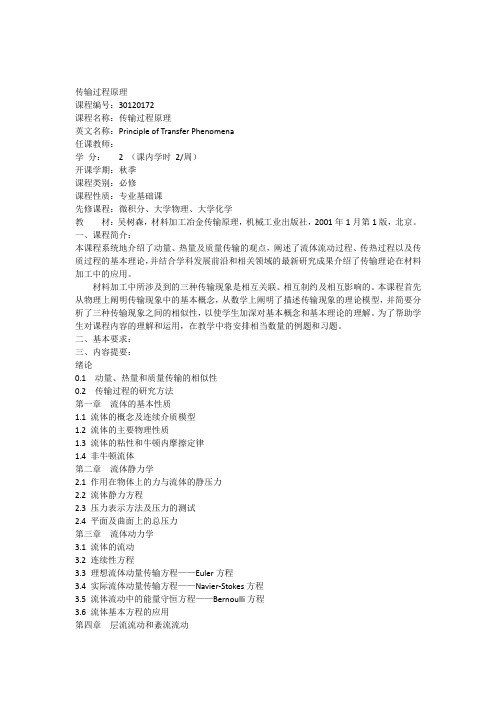
传输过程原理课程编号:30120172课程名称:传输过程原理英文名称:Principle of Transfer Phenomena任课教师:学分: 2 (课内学时2/周)开课学期:秋季课程类别:必修课程性质:专业基础课先修课程:微积分、大学物理、大学化学教材:吴树森,材料加工冶金传输原理,机械工业出版社,2001年1月第1版,北京。
一、课程简介:本课程系统地介绍了动量、热量及质量传输的观点,阐述了流体流动过程、传热过程以及传质过程的基本理论,并结合学科发展前沿和相关领域的最新研究成果介绍了传输理论在材料加工中的应用。
材料加工中所涉及到的三种传输现象是相互关联、相互制约及相互影响的。
本课程首先从物理上阐明传输现象中的基本概念,从数学上阐明了描述传输现象的理论模型,并简要分析了三种传输现象之间的相似性,以使学生加深对基本概念和基本理论的理解。
为了帮助学生对课程内容的理解和运用,在教学中将安排相当数量的例题和习题。
二、基本要求:三、内容提要:绪论0.1 动量、热量和质量传输的相似性0.2 传输过程的研究方法第一章流体的基本性质1.1 流体的概念及连续介质模型1.2 流体的主要物理性质1.3 流体的粘性和牛顿内摩擦定律1.4 非牛顿流体第二章流体静力学2.1 作用在物体上的力与流体的静压力2.2 流体静力方程2.3 压力表示方法及压力的测试2.4 平面及曲面上的总压力第三章流体动力学3.1 流体的流动3.2 连续性方程3.3 理想流体动量传输方程——Euler方程3.4 实际流体动量传输方程——Navier-Stokes方程3.5 流体流动中的能量守恒方程——Bernoulli方程3.6 流体基本方程的应用第四章层流流动和紊流流动4.1 流体流动状态及阻力分类4.2 流体的层流运动4.3 流体的紊流运动4.4 沿程阻力系数4.5 局部阻力第五章边界层流动5.1 边界层理论的基本概念5.2 平面层流边界层微分方程5.3 边界层内的积分方程5.4 平面绕流摩擦阻力计算第六章多相流动6.1 气液两相流6.2 气固两相流6.3 液固两相流6.4 射流第七章相似原理和量刚分析7.1 相似的概念7.2 相似准则7.3 相似定律7.4 量刚分析基础7.5 相似模型研究法第八章动量传输在材料加工中的应用8.1 液体金属的充型过程8.2 液体金属的净化8.3 射砂过程第九章热量传输的基本概念9.1 热量传输方式及Fourier导热定律9.2 温度场、等温面和温度梯度9.3 导热系数与热扩散系数第十章热传导10.1 导热微分方程10.2 稳定导热10.3 导热过程中的界面热阻10.4 不稳定导热第十一章对流换热11.1 对流换热的机理及影响因素11.2 对流换热微分方程组11.3 对流换热的准则方程11.4 强制对流换热11.5 自然对流换热第十二章辐射换热12.1 热辐射的基本概念12.2 热辐射的基本定律12.3 固体和液体及灰体的辐射12.4 黑体间的辐射换热及角系数12.5 灰体间的辐射换热12.6 气体辐射12.7 对流与辐射共同存在时的热量传输第十三章纳米材料和生物材料中的传热13.1 纳米材料中的传热13.2 纳米材料传热基本方程13.3 生物材料中的传热13.4 生物材料中传热的基本方程第十四章热量传输在材料加工中的应用14.1 凝固过程传热14.2 焊接过程温度场14.3 热处理传热14.4 粉末制备中的传热第十五章质量传输基本概念和传质微分方程15.1 浓度、速度和扩散通量密度15.2 扩散系数15.3 质量传输微分方程15.4 扩散方程定解条件第十六章分子传质16.1 一维稳定态分子扩散16.2 非稳定态分子扩散第十七章对流传质17.1 对流传质概述17.2 圆管内的对流传质17.3 对流传质系数的关联式17.4 传质系数模型第十八章质量传输在材料加工中的应用18.1 凝固过程中的传质18.2 相间稳态传质和双膜理论18.3 气液反应中的扩散18.4 气固反应中的扩散18.5 多孔材料中的稳态扩散基本教学内容与学时安排●绪论(2学时)动量、能量与质量传输的类似性传输过程的研究方法要求重点掌握内容:动量、热量与质量传输的类似性要求一般掌握内容:传输过程的研究方法●流体的性质(4学时)流体的概念及连续介质模型流体的主要物理性质流体的粘性及内摩擦定律牛顿流体与非牛顿流体要求重点掌握内容:流体的连续介质模型、流体的主要物理性质、流体的粘性和内摩擦定律。
【化工传递过程基础】Transport_Phenomena_19
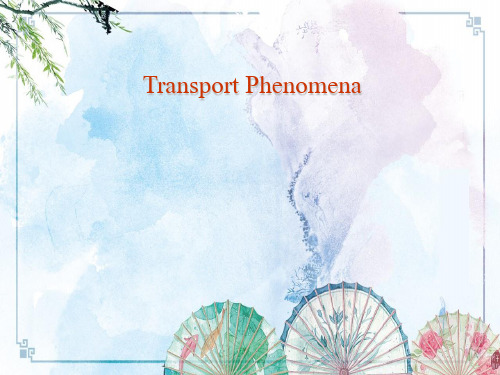
Transport Phenomena
For polymeric liquids, experimental data suggest that the following equations are reasonable:
where n is a positive parameter characterizing the fluid, usually with a value less than unity. That is, the velocity profile is more blunt than it is for the Newtonian fluid, for which n = 1.
themegallery
Transport Phenomena
Polymeric liquids are encountered in the fabrication of plastic objects, and as additives to lubricants, foodstuffs, and inks. They represent a vast and important class of liquids. Polymer fluid dynamics, heat transfer, and diffusion form a rapidly growing part of the subject of transport phenomena.
themegallery
Transport Phenomena
In previous chapters, we have considered only Newtonian fluids. The relations between stresses and velocity gradients are described by Eq. 1.1-2 for simple shear flow and by Eq. 1.26 (or Eq. 1.2-7) for arbitrary time-dependent flows.
【化工传递过程基础】Transport_Phenomena_31
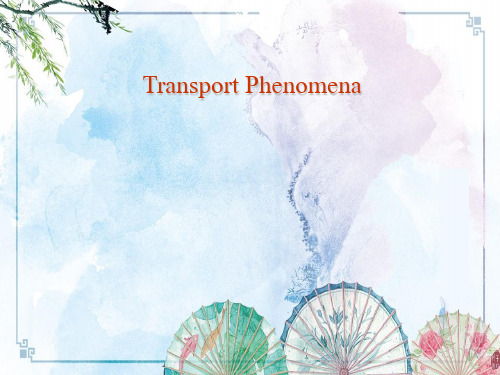
themegallery
Transport Phenomena
Here we have taken
to be constant, at the value for
themegallery
Math Vocabulary I
6. natural number positive number negative number odd integer, odd number even integer, even number integer, whole number positive whole number negative whole number consecutive number real number,实数 rational number, irrational(number) inverse composite number合数 prime number质数 reciprocal common divisor multiple (least)common multiple(最小)
It can be seen that the temperature profile is not linear for
this system except in the limit as
. Note the
similarity between Eqs. 19.4-6 and 8.
themegallery
Transport Phenomena
Content in the Previous Class
The Transport of Heat and Mass in Fluids

The Transport of Heat and Mass inFluids热传导和质量传输是液体和气体中非常重要的物理现象,为化学、物理、材料科学等领域的研究提供了基础。
本文将探讨液体和气体中的热传导和质量传输,包括其定义、机制和应用领域。
一、热传导热传导是指在物体内部或不同物体之间由于温度差异产生的热能传递过程,其机制由分子热运动引起。
当物体内部温度不均时,高温处的分子的热运动会使其周围的低温分子热运动增加,从而导致温度的均匀分布,这种热能传递的方式被称为热传导。
相对于其他能量传递方式,如辐射传热和对流传热来说,热传导的能量传递速率相对较慢,但其在自然界和工业领域中的应用非常广泛。
在流体中,热传导是通过分子的热运动传导的。
因此,在液体或气体中,热传导存在一定的限制,因为分子之间的距离很大,分子之间的碰撞频率较低。
因此,在流体中,导热系数非常小,即使在相同温度变化下,热传导在液体中比在固体中慢得多。
液体中的热传导可以通过热传导方程来表示,该方程形式如下:q = -κ ΔT / Δx其中,q是在温度差ΔT下单位时间和单位面积的热量,κ是热导率,Δx是在流体中存在温度差的距离。
二、质量传输质量传输是指物质从一个区域向另一个区域移动的过程,其机制由质子的热运动产生。
质量传输有两种形式:扩散和对流。
扩散是指物质由高浓度向低浓度传递的过程。
如果两个区域的浓度相等,则不再发生扩散。
在流体中扩散的速率取决于浓度梯度的大小、流体的粘度和温度等因素。
其速率可以由Fick's第一和第二定律来描述:第一定律说明了在无流动情况下物质扩散的速率是与浓度梯度成正比的;第二定律说明了在有流动的情况下,浓度梯度将受到加速或减缓。
对流是物质由某种流动方式从一处向另一处移动,它由流体的流动引起,其速度取决于流体的速率和流体的粘度。
对流传输是用于液体混合和气体扩散的重要过程。
它可以由计算流体力学模型,如Navier-Stokes方程来描述。
传递用英语怎么说

传递用英语怎么说传递是指递过去,辗转递送,例如:电话能传递声音。
那么你知道传递用英语怎么说吗?下面来学习一下吧。
传递英语说法1:transmit传递英语说法2:deliver传递英语说法3:pass on传递的英语例句:请把这份文件依次传递给他人。
Please hand on the document to others.分支指令由这种控制传递方式的结果而执行的指令The instructions executed as the result of such a passing of control.用可视提示或声音传递任何通过颜色传递的信息。
Convey by visual cues or sound any information that is conveyed through color.传递服务负责将通知最终传递给订阅方。
The delivery services handle the final delivery to the subscribers.由一矩形腔体声传递函数的求解实例,证明了这种声传递函数求解方法的可行性。
An example applied to a rectangular cavity shows validity of this method.传递通道表示一个特定的传递端点。
A delivery channel represents a specific delivery endpoint.报表服务器传递扩展插件用于传递报表。
The report server delivery extensions are used to deliverreports.传递途中,出于安全考虑,火炬两次被熄灭,改用公共汽车传递。
Officials twice extinguished the torch and put it on a bus for safety reasons.他希望削减超过十万工人,密切数千邮局和结束星期六的邮件传递。
- 1、下载文档前请自行甄别文档内容的完整性,平台不提供额外的编辑、内容补充、找答案等附加服务。
- 2、"仅部分预览"的文档,不可在线预览部分如存在完整性等问题,可反馈申请退款(可完整预览的文档不适用该条件!)。
- 3、如文档侵犯您的权益,请联系客服反馈,我们会尽快为您处理(人工客服工作时间:9:00-18:30)。
The scalar product of del with a vector V is known as the divergence of V, and is written as: V y Vx Vz .V divV x y z
k z Vz
Another important expression is “del squared”, also known as the “Laplacian”:
2f .f div grad f f f f , , . , , x y z x y z f f f x x y y z z 2f 2f 2f 2 2 x y z 2
Thus, Fick's First Law states: J = -D [ ∂C(x,t) / ∂x ] where J is the flux, D is the diffusion constant for the material that is diffusing in the specific solvent, and ∂C(x,t)/∂x is the concentration gradient. The diffusion constant of a material is also referred to as 'diffusion coefficient' or simply 'diffusivity.' It is expressed in units of length2/time, such as µm2/hour. The negative sign of the right side of the equation indicates that the impurities are flowing in the direction of lower concentration.
Ay Bz Az B y i A B A B e A B sin Az Bx Ax Bz Ax Ax B y Ay Bx Bx Unit vector perpendicular
to A and B
A.B Ax Bx Ay B y Az Bz A B cos
Fick's Second Law
Fick's First Law does not consider the fact that the gradient and local concentration of the impurities in a material decreases with an increase in time, an aspect that's important to diffusion processes.
We define the curl of V as:
Flat brackets mean “take determinant”
i j Vz V y Vx Vz V y Vx j V curlV i z x k x y x y z y Vx V y
j Ay By
k Az Bz
where i, j, k are unit vectors in the x, y, z dir., respectively
We can define a vector operator called “del” , written as: It is more complicated than normal partial i j k , , x y z x y z differentials as it is a vector ! We can define the product of del with a scalar f as:
The flux J1 of impurities entering a section of a bar with a concentration gradient is different from the flux J2 of leaving the same section. From the law of conservation of matter, the difference between J1 and J2 must result in a change in the concentration of impurities within the section (assuming that no impurities are formed or consumed in the section). This is Fick's Second Law, which states that the change in impurity concentration over time is equal to the change in local diffusion flux, or ∂C(x,t)/∂t = - ∂J/∂x or, from Fick's First Law, ∂C(x,t)/∂t = ∂(D∂C(x,t)/∂x)/∂x. If the diffusion coefficient is independent of position, such as when the impurity concentration is low, then Fick's Second Law may be further simplified into the following equation: ∂C(x,t)/∂t = D ∂2C(x,t)/∂x2.
Fick's Laws
Diffusion the movement of a chemical species from an area of high concentration to an area of lower concentration, is one of the two major processes by which chemical species or dopants are introduced into a semiconductor (the other one being ion implantation) . The controlled diffusion of dopants into silicon to alter the type and level of conductivity of semiconductor materials is the foundation of forming a p-n junction and formation of devices during wafer fabrication. The mathematics that govern the mass transport phenomena of diffusion are based on Fick's laws.
传递过程原理-附录
刘相东
绕圆柱流模拟
射流模拟
雷诺试验
绕圆柱流演示
流线演示
Shorthand Notation in Vector Equations
f x
= partial differential operator Means: differentiate contents of brackets with respect to x and treating all other variables as constants Scalar product By definition the scalar product of two vectors A (=A= (Ax,Ay,Az)) and B (= B = (Bx,By,Bz)) is given by: where is the angle between the two vectors A and B. Vector product By definition the vector product of two vectors A and B is given by:
Fick's First Law
Whenever an impurity concentration gradient, ∂C/∂x, exists in a finite volume of a matrix substance (the silicon substrate in this context), the impurity material will have the natural tendency to move in order to distribute itself more evenly within the matrix and decrease the gradient. Given enough time, this flow of impurities will eventually result in homogeneity within the matrix, causing the net flow of impurities to stop. The mathematics of this transport mechanism was formalized in 1855 by Fick, who postulated that the flux of material across a given plane is proportional to the concentration gradient across the plane.
